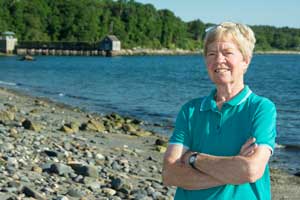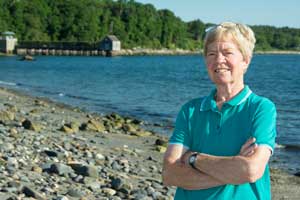 NARRAGANSETT, R.I. – August 20, 2015 – A team of oceanographers from the University of Rhode Island has completed a 10-year study of water quality in Narragansett Bay and found that reductions in nitrogen discharged into the bay from sewage treatment plants has resulted in much clearer water and fewer algae blooms. But run-off from heavy rainstorms still leads to poor water quality.
NARRAGANSETT, R.I. – August 20, 2015 – A team of oceanographers from the University of Rhode Island has completed a 10-year study of water quality in Narragansett Bay and found that reductions in nitrogen discharged into the bay from sewage treatment plants has resulted in much clearer water and fewer algae blooms. But run-off from heavy rainstorms still leads to poor water quality.
According to Professor Candace Oviatt at the URI Graduate School of Oceanography, regulations required the state’s 11 coastal wastewater treatment plants to reduce their discharges of nitrogen into the bay by 50 percent. The facilities achieved a 30 percent reduction by 2005, when the URI study began, and the remainder by 2013.
“The objective of our study was really to better understand hypoxia – a lack of oxygen – in the bay and determine how it was related to high nitrogen concentrations,” said Oviatt, who received a lifetime achievement award from Save the Bay and the Bostwick H. Ketchum Award from the Woods Hole Oceanographic Institution this year.
Nitrogen from wastewater treatment plants is largely responsible for the excessive growth of algae, which then sinks to the bottom and rapidly uses up all the available oxygen in the water. It can lead to large-scale fish kills, such as happened in Greenwich Bay in 2003.
The researchers collected data from a summer network of 12 instruments in upper Narragansett Bay that measure water temperature, salinity, oxygen, chlorophyll and pH. They also analyzed monthly nutrient samples collected from 13 locations. And they created a series of computer models to predict how Narragansett Bay would respond to the reduced nitrogen.
Oviatt said her data confirmed that the wastewater treatment plants achieved the 50 percent reduction in nitrogen discharges. That reduction has resulted in a 15 percent decrease in phytoplankton growth in the upper bay and 25 to 30 percent decrease in the mid-bay.
As a result, the water in Narragansett Bay has become noticeably clearer. Water in the upper bay is now as clear as in the lower bay. It is so clear, in fact, that many fishermen are worried that the water has been poisoned.
“The water is clear, that’s for sure,” Oviatt said. “But there is no pollutant in the water that is killing things and making it clear. It’s due to the lack of nutrients.”
One objective of the reduction in nitrogen discharges was to control the hypoxia episodes in Narragansett Bay, but Oviatt said hypoxia is not yet completely under control. During dry years, like 2014, low oxygen still occurs but in shorter and less intense events. In rainy years like 2013, however, freshwater run-off creates a cap over the salt water and enhances the likelihood of hypoxia episodes.
“I think we’re making progress, but in rainy years we’re still going to have hypoxia,” Oviatt said. “The next step is to keep an eye on how habitats respond. Are there more fish in the upper bay? Is there enough food available for aquaculture? The level of nutrients in the water now probably isn’t causing harm, but we should continue to assess it.”
Oviatt said that the one area of Narragansett Bay where water quality remains poor is Greenwich Bay, but it has little to do with wastewater discharges.
“The treatment plant there achieved its reductions, at least intermittently, but other nitrogen is coming into the bay through the groundwater that the plant has no control over,” she said. “The groundwater is picking up nutrients from cesspools and septic fields, and it will be a while before it wears out. The water quality there is still improved, but it’s got a way to go.”
The URI professor credits the Rhode Island Department of Environmental Management and the wastewater treatment plants for the improved water quality in Narragansett Bay. “DEM did a wonderful job of imposing the regulations and making sure the treatment plants reduced their discharges,” she said. “DEM and the treatment plants deserve the credit.”
Pictured above:
URI Graduate School of Oceanography Professor, Candace Oviatt.

